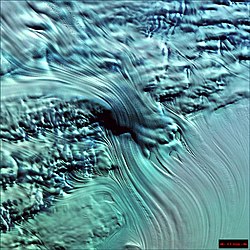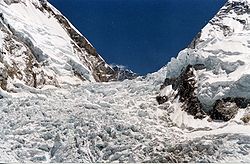Icefall: Difference between revisions
m Fixed interwiki |
No edit summary |
||
| Line 46: | Line 46: | ||
[[Category:Glaciology|Icefall]] |
[[Category:Glaciology|Icefall]] |
||
[[de:Eisbruch]] |
|||
[[is:Skriðjökull]] |
[[is:Skriðjökull]] |
||
[[pl:Lodospad]] |
[[pl:Lodospad]] |
||
Revision as of 11:44, 24 July 2008

An icefall is a portion of some glaciers characterized by rapid flow and a chaotic crevassed surface. Perhaps the most conspicuous consequence of glacier flow, icefalls occur where the glacier bed steepens and/or narrows. The term icefall is formed by analogy with the word waterfall, a similar, but much higher speed, flow phenomenon.
Most glacier ice flows at speeds of a few hundred meters per year or less. However, the flow of ice in an icefall may reach thousands of meters per year. Such rapid flow cannot be accommodated by plastic deformation of the ice. Instead, the ice fractures forming crevasses. Intersecting fractures form ice columns or seracs. These processes are imperceptible for the most part, however, a serac may collapse or topple abruptly and without warning. This behavior often poses the biggest risk to mountaineers climbing in an icefall.
Below the icefall, the glacier bed flattens and/or widens and the ice flow slows. Crevasses close and the glacier surface becomes much smoother and easier to traverse.

Icefalls vary greatly in height. The Roosevelt Glacier icefall, on the north face of Mount Baker (Cascade Range, U.S.), is about 730 metres (2,400 ft) high (photograph at right). The ice cliff of the left side of the ice fall and above the debris covering the glacier is 20 to 40 metres (70 to 140 ft) high. Typical of mountain glaciers, this icefall forms as the ice flows from a high elevation plateau or basin accumulation zone to a lower valley ablation zone. Much larger icefalls may be found in the outlet glaciers of continental ice sheets. The icefall feeding the Lambert Glacier in Antarctica (photograph at left) is 7 kilometres (4.4 mi) wide and 14 kilometres (9 mi) long, even though the elevation difference is only 400 meters (1,300 ft), a little more than half that of the Roosevelt Glacier icefall.
Icefalls are climbed because of their beauty and the challenge they pose. In some cases, an icefall may provide the only feasible or the easiest route up one face of a mountain. An example is the Khumbu Icefall on the Nepalese side of Mount Everest, variously described as "treacherous" and "dangerous." It is about 5,500 metres (18,000 ft) above sea level.


References
- Post, Austin (2000) [1971]. Glacier Ice (Revised edition ed.). Seattle, Washington: University of Washington Press. pp. pp. 18-21. ISBN 0-295-97910-0.
{{cite book}}:|edition=has extra text (help);|pages=has extra text (help); Cite has empty unknown parameters:|accessyear=,|origmonth=,|accessmonth=,|chapterurl=, and|origdate=(help); Unknown parameter|coauthors=ignored (|author=suggested) (help); Unknown parameter|month=ignored (help)
